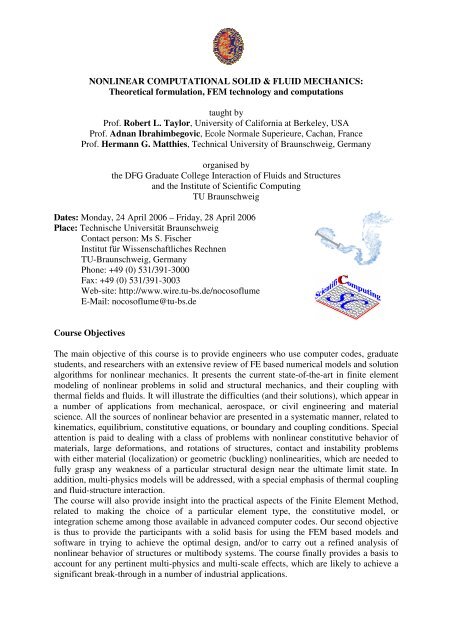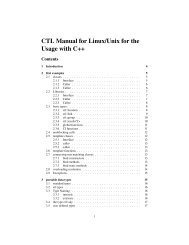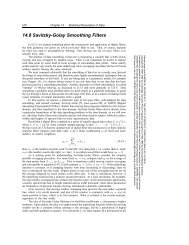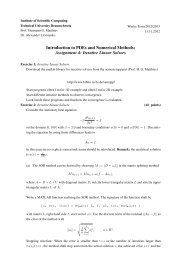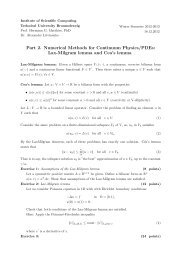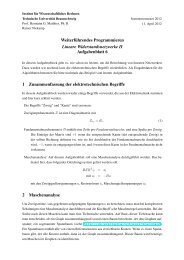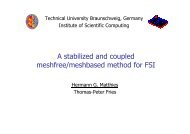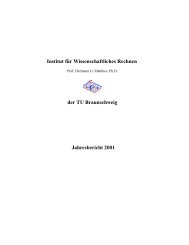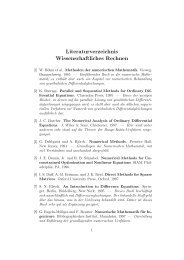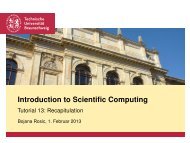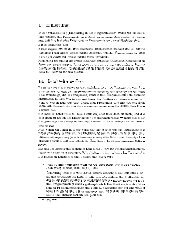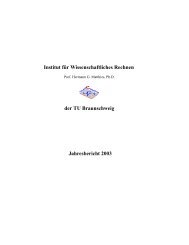NONLINEAR COMPUTATIONAL SOLID & FLUID MECHANICS ...
NONLINEAR COMPUTATIONAL SOLID & FLUID MECHANICS ...
NONLINEAR COMPUTATIONAL SOLID & FLUID MECHANICS ...
You also want an ePaper? Increase the reach of your titles
YUMPU automatically turns print PDFs into web optimized ePapers that Google loves.
<strong>NONLINEAR</strong> <strong>COMPUTATIONAL</strong> <strong>SOLID</strong> & <strong>FLUID</strong> <strong>MECHANICS</strong>:<br />
Theoretical formulation, FEM technology and computations<br />
taught by<br />
Prof. Robert L. Taylor, University of California at Berkeley, USA<br />
Prof. Adnan Ibrahimbegovic, Ecole Normale Superieure, Cachan, France<br />
Prof. Hermann G. Matthies, Technical University of Braunschweig, Germany<br />
organised by<br />
the DFG Graduate College Interaction of Fluids and Structures<br />
and the Institute of Scientific Computing<br />
TU Braunschweig<br />
Dates: Monday, 24 April 2006 – Friday, 28 April 2006<br />
Place: Technische Universität Braunschweig<br />
Contact person: Ms S. Fischer<br />
Institut für Wissenschaftliches Rechnen<br />
TU-Braunschweig, Germany<br />
Phone: +49 (0) 531/391-3000<br />
Fax: +49 (0) 531/391-3003<br />
Web-site: http://www.wire.tu-bs.de/nocosoflume<br />
E-Mail: nocosoflume@tu-bs.de<br />
Course Objectives<br />
The main objective of this course is to provide engineers who use computer codes, graduate<br />
students, and researchers with an extensive review of FE based numerical models and solution<br />
algorithms for nonlinear mechanics. It presents the current state-of-the-art in finite element<br />
modeling of nonlinear problems in solid and structural mechanics, and their coupling with<br />
thermal fields and fluids. It will illustrate the difficulties (and their solutions), which appear in<br />
a number of applications from mechanical, aerospace, or civil engineering and material<br />
science. All the sources of nonlinear behavior are presented in a systematic manner, related to<br />
kinematics, equilibrium, constitutive equations, or boundary and coupling conditions. Special<br />
attention is paid to dealing with a class of problems with nonlinear constitutive behavior of<br />
materials, large deformations, and rotations of structures, contact and instability problems<br />
with either material (localization) or geometric (buckling) nonlinearities, which are needed to<br />
fully grasp any weakness of a particular structural design near the ultimate limit state. In<br />
addition, multi-physics models will be addressed, with a special emphasis of thermal coupling<br />
and fluid-structure interaction.<br />
The course will also provide insight into the practical aspects of the Finite Element Method,<br />
related to making the choice of a particular element type, the constitutive model, or<br />
integration scheme among those available in advanced computer codes. Our second objective<br />
is thus to provide the participants with a solid basis for using the FEM based models and<br />
software in trying to achieve the optimal design, and/or to carry out a refined analysis of<br />
nonlinear behavior of structures or multibody systems. The course finally provides a basis to<br />
account for any pertinent multi-physics and multi-scale effects, which are likely to achieve a<br />
significant break-through in a number of industrial applications.
Participants:<br />
The course is suitable for all engineers and researchers who want to improve their skills with<br />
using a refined modeling approach in nonlinear mechanics. In particular, those who are<br />
developing their own tools (with an illustration of the research code FEAP), and those who<br />
seek to make a more efficient use of existing codes (with a demonstration of the codecoupling<br />
interface CTL) will find the course very helpful. Moreover, all those who would like<br />
to reinforce their understanding of the theoretical basis of problems in nonlinear mechanics<br />
and an illustration of current research in Computational Mechanics will be well served<br />
through the course notes and a book. This course (in a somewhat reduced format) has already<br />
been held several times since 2000 in France, and has proved very successful. Among the<br />
previous participants, those with background in engineering or applied mathematics, as well<br />
as those with previous knowledge of basic FEM procedures for linear problems, found the<br />
course most profitable.<br />
Professors:<br />
Robert L. Taylor obtained his PhD in Engineering in 1963 at the University of California at<br />
Berkeley, USA. Subsequently, he was appointed professor in mechanics at the Department of<br />
Civil Engineering, where he currently holds the appointment of the Professor at the UC<br />
Berkeley Graduate School. He has become a member of US National Academy of Engineers<br />
in 1992, and since has received a number of distinctions (including the von Neumann Medal<br />
of IACM) and honorary doctorates, such as the ones from University of Wales at Swansea,<br />
UK and University of Hannover, Germany. The scientific contribution of Prof. Taylor count<br />
more than 200 papers in scientific journals, co-authorship with Prof. Zienkiewicz of the most<br />
well-known books on finite element method, as well as the finite element computer program<br />
FEAP which is used by a large number of universities in the USA and Europe. Perhaps the<br />
best confirmation of extraordinary teaching skills of Prof. Taylor is an impressive list of wellknown<br />
researchers who were his students and scholars.<br />
Adnan Ibrahimbegovic has obtained his engineering education in Sarajevo (winner of 1986<br />
Fulbright Grant), PhD at the University of California at Berkeley, USA and Habilitation at the<br />
University of Pierre and Marie Curie (Paris VI), France. He has held professorships and<br />
research positions at four different universities (including UC Berkeley, EPFL in Switzerland<br />
and UTC in France). Since 1999, he is the Head of Civil Engineering Division of LMT-<br />
Cachan, the largest French laboratory in mechanics. He has received a number of international<br />
distinctions, including NSERC fellowship for Canada and Humboldt Prize for senior<br />
researchers for Germany. He has published over 100 papers in scientific journals and a couple<br />
of advanced textbooks in nonlinear computational solid mechanics.<br />
Hermann G. Matthies has obtained his initial degree from the TU Berlin, Germany; and his<br />
doctoral degree in mathematics at MIT, Cambridge, USA in 1978, working on FEM and<br />
plasticity. Subsequently he has worked in various positions in industrial research and<br />
engineering in diverse fields such as wind, offshore, and ice engineering. Since 1995 he heads<br />
the Institute of Scientific Computing at the TU Braunschweig, Germany; and since 1996 he is<br />
additionally the director of the University Computing Centre. He has received several<br />
international distinctions, among them the Fellowship Award of the IACM. He has published<br />
over 100 papers, as well as edited conference proceedings and topical special issues on<br />
scientific journals.
Course Program<br />
Monday, 24 April 2006<br />
1. Introduction: variational formulations in nonlinear solid mechanics (AI)<br />
• Strong, weak and variational forms of 1D BVP in linear and nonlinear<br />
elasticity<br />
• Basic solution methods: Gauss elimination and Newton iterations<br />
• FEM technology in 1D problems: truss/bar element<br />
2. Numerical implementation in FEM codes (example of FEAP) (RLT)<br />
• FEM technology in 1D structural problems: Euler-Bernoulli and<br />
Timoshenko beam models<br />
• Macro command programming language<br />
• Programming in FEAP environment<br />
3. Numerical solution of discrete models in BVP (HGM)<br />
• Direct solvers, iterative solvers<br />
• Nonlinear problem solvers<br />
• Algorithm analysis<br />
• Time-integration schemes<br />
4. FEM technology for 2D/3D BVP in elasticity (AI)<br />
• 2D/3D models: thermal and mechanics problems<br />
• Isoparametric elements and numerical integration<br />
• Non-conventional interpolations and solid elements with drilling<br />
degrees of freedom<br />
Tuesday, 25 April 2006<br />
5. Enhancing FEM performance – element technology (RLT)<br />
• Structural models: plates and shells<br />
• Hybrid and mixed models<br />
• Enhanced strain models
6. Inelastic constitutive behavior at small strains (AI)<br />
• Thermomechanics with internal variables<br />
• Refined constitutive models of plasticity, damage and coupled damageplasticity<br />
• Solution of weak form with internal variables<br />
7. Implementation and performance of nonlinear constitutive models in FEM framework<br />
(RLT)<br />
• Integration of evolution equations<br />
• Operator split method and consistent tangent modulus<br />
• Locking problems in plasticity<br />
• Choice of element type<br />
8. Solution techniques for non-linear transient problems (HGM)<br />
• Nonlinear heat transfer, nonlinear dynamics<br />
• Explicit vs. implicit integration schemes<br />
• Generalized a-scheme and schemes for stiff equations<br />
• Galerkin method in time<br />
Wednesday, 26 April 2006<br />
9. Nonlinear solid mechanics problems at large displacements (AI)<br />
• Kinematics and strain measure at large displacement<br />
• Lagrangian and Eulerian formulations; Consistent linearisation<br />
• Nonlinear elasticity and poly-convexity conditions<br />
• Constitutive law at large deformations: plasticity<br />
10. Contact problems (RLT)<br />
• Formulation of contact problems (penalty, augmented Lagrangian)<br />
• Implementation of mortar method and stress computation<br />
• Impact dynamics and contact
11. Nonlinear fluid mechanics problems at large displacements (HGM)<br />
• Navier-Stokes equations<br />
• Arbitrary Lagrangian-Eulerian formulation<br />
• Alternative techniques to FEM<br />
12. Nonlinear structural mechanics / I (AI)<br />
• Computational aspects of large 3D rotations<br />
• Geometrically exact beam model of Reissner and Simo<br />
• Locking problems for structures<br />
Thursday, 27 April 2006<br />
13. Non stationary evolution problems and coupled problems (HGM)<br />
• Fluid-solid interaction<br />
• Solution of coupled problems<br />
• Solution of constrained differential equations (DEA)<br />
14. Nonlinear structural mechanics / II (AI)<br />
• Geometrically exact shell models with or without drilling rotations<br />
• Locking problems in shells<br />
• Dynamics and time-integration schemes for shells<br />
15. Flexible multibody system dynamics (RLT)<br />
• Formulation of multibody systems: holonomic and non-holonomic<br />
constraints<br />
• Modeling of flexible multibody systems and cost reduction: rigid<br />
component approximation<br />
16. Instability of structures and systems (HGM/AI)<br />
• Geometric instability: (buckling) vs. material instability (localization)<br />
• Solution of problems in presence of critical points<br />
• Classification of equilibrium critical points
• Dynamic instability problems<br />
Friday, 28 April 2006<br />
17. Advanced aspects of multi-physics and multi-scale problems (RLT/AI)<br />
• Modeling of nonlinear multi-physics problems: example of<br />
themomechanical coupling<br />
• Multi-scale models of inelastic behavior<br />
18. Solution methods for coupled and interaction problems within multi-physics and multiscale<br />
framework (HGM)<br />
• Illustration of fluid-solid interaction problems<br />
• Software architecture and code coupling<br />
• Including the stochastic aspects
COURSE ORGANIZATION<br />
Registration<br />
Early registration is suggested because enrollment is limited.<br />
For registration please see:<br />
http://edu2.zfw.etc.tu-bs.de/nocosoflume/registration.html<br />
For further questions please mail to:<br />
E-Mail: nocosoflume@tu-bs.de<br />
Course Materials<br />
The course material will consist of copies of transparencies from the lectures, survey papers<br />
by the lecturers, recent manuscripts not yet in press, lecture notes, and the advanced textbook<br />
edited by A. Ibrahimbegovic on “Multi-physics and multi-scale computer models for<br />
nonlinear analysis and optimal design of engineering structures under extreme conditions”.<br />
The copies of computer codes Finite Element Analysis Program (FEAP), written by Prof.<br />
Robert L. Taylor at UC Berkeley, and the Component Template Library (CTL) for codecoupling<br />
and parallel-computing platform, developed at TU Braunschweig, and the complete<br />
volume of notes is available only to attendees.<br />
Fee<br />
The registration fee for this course is 2075 €, and includes admission to the lectures, coffee<br />
breaks, an evening reception, and the course notes and texts. Full-time university affiliates<br />
and members of public research centres are entitled to a reduced fee of 1675 €. A limited<br />
number of PhD students (proof of status required) will be entitled to a reduced fee of 675 €.<br />
Location<br />
The course will be held at the TU Braunschweig<br />
Accommodations<br />
There are a number of Hotels in the area. Arrangements should be made directly. Also, the<br />
Tourist Office can help: www.bs-touristoffice.com.<br />
Daily Schedule<br />
Registration starts at 8:30 on Monday.<br />
The lectures start at 9:00 and end at 17:00, Monday-Thursday (4 lectures each 1h15),<br />
and 9:00 to 12:00, Friday (2 lectures each 1h15)<br />
Lunch and coffee breaks are provided for all participants to be taken with the lecturers.<br />
Cancellation Policy<br />
For cancellations made prior to 24 March 2006, the full registration fee will be refunded.<br />
After that date, 100 € cancellation charge will be deducted. No refunds will be made after 17<br />
April 2006. However, registration is transferable to another member of the same organisation.


